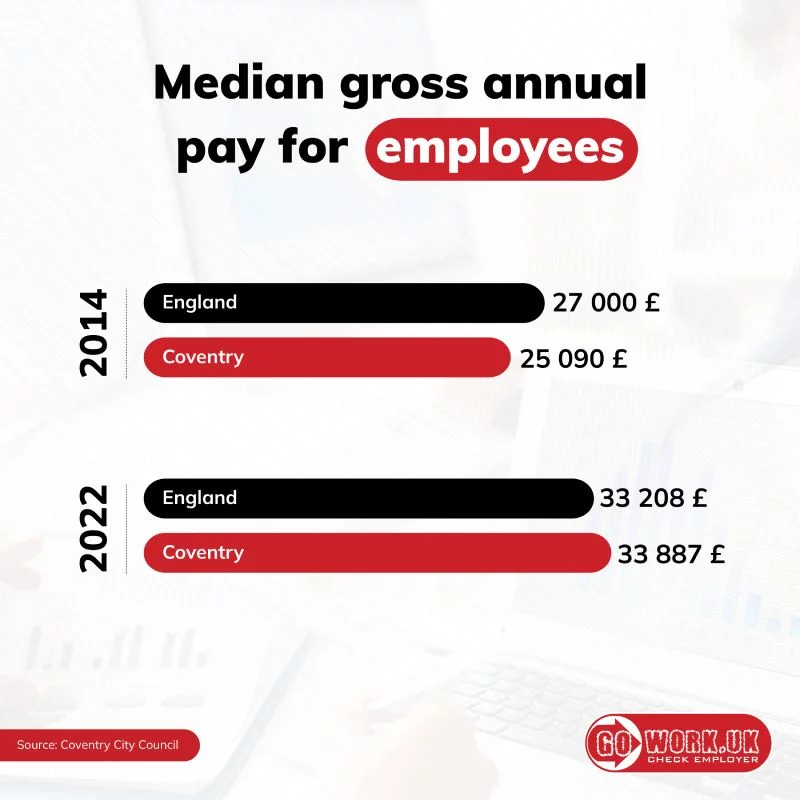Coventry’s Industrial Evolution: Bridging the Gap in a Transforming Labour Market

Although Coventry is already known for being the heart of the UK automotive industry, it is now also at the forefront of a revolution characterised by ground-breaking technological advances and a shift towards a more diverse and innovative economy. Let’s take a look at the latest trends and developments in Coventry’s labour market and explore how the fusion of tradition and technological innovation is creating so many great opportunities for career growth.
Table of Contents
Automotive Sector
Coventry region is home to over 1,500 dedicated automotive suppliers. Major international companies like Jaguar Land Rover, BMW, General Electric, and Aston Martin Lagonda anchor the area’s advanced manufacturing and engineering sector, which employs around 34,000 people according to Careers Inspiration. This transformation is part of a broader trend in Coventry and Warwickshire, where the financial, business, and professional services sectors also play a significant role, employing over 84,000 people. The region’s commitment to innovation and technological advancement is further evidenced by its well-established ICT sector.
Thriving Gaming and ICT Hub
In the era of the upheaval in Coventry’s car industry, the labour market in the region has changed drastically. One sign of this change is the ICT industry in Coventry and Warwickshire, particularly in the ‘Silicon Spa‘ region, which includes Leamington Spa, Warwick and Southam.
Here, the games and creative sector is experiencing rapid growth thanks to the efforts of over 30 gaming studios, including well-known brands such as Codemasters, Exient and Ubisoft Leamington. Together, these studios employ around 2,000 people, boosting the local economy and diversifying the employment environment. This boom in the gaming industry supports the more established sectors and shows that Coventry can successfully combine its strong industrial history with the latest technological developments.
In addition, the public sector plays a key role in enriching the region’s labour market dynamics. In Coventry and Warwickshire, over 25% of the labour force is employed in public services, education, health and social care. This high level of employment in robust sectors demonstrates the region’s strong growth potential and commitment to social services and community wellbeing. Balancing the ever-growing importance of public sector jobs with rapid advances in manufacturing and technology, Coventry’s economic resilience is strengthened. This diverse labour market in Coventry and Warwickshire is a telling sign of a region that is adapting to change and growing as a result.
Low Participation, High Vacancies
The report commissioned by the Local Government Association and conducted by the Institute for Employment Studies, presents a comprehensive analysis of local labour markets across England. This report categorizes areas based on labour force participation and vacancy rates, offering a view of how different regions are experiencing the market dynamics. What’s interesting, Coventry finds itself in a unique category characterized by low participation but high vacancies. This classification indicates a job market with many job openings not being met by the local workforce, a situation that could be attributed to a mismatch in skills or other socio-economic factors.
Also the employment rate is a bit lower than the average in England. Coventry City Council gives us information, that the regional percentage of employment is 5 percentage points lower (70,5% to 75,7%) What does it prove?
In the context of Coventry, this finding from the report presents both challenges and opportunities. As we already know, the local market is full of opportunities, for example in the automotive sector. The high vacancy rate suggests a growing demand for skilled labour that is not currently being met. This gap presents a critical opportunity for workforce development, particularly in aligning skills with the evolving needs of Coventry’s diverse economy, which now includes a thriving ICT sector and public sector employment.
Addressing these challenges will be crucial for Coventry to fully grasp its industrial revolution and technological advancements, ensuring that the regional development continues to create rewarding career opportunities for its residents and potential visitors.

Challenge and the Opportunity
Although there are visible challenges, they create a great opportunity for improvement both for employers and employees. The city is well-positioned for economic change due to its solid industrial base and growth in high-tech sectors. Developing targeted education and training programmes that meet the needs of the public sector, automotive and ICT industries is one way to reduce the low labour force participation rate.
Improving vocational training programmes and building alliances between universities and businesses can be one of the ways to find the solution. Initiatives to draw and retain talent, such as improving living standards and providing competitive wages, can obviously help to reduce the high rates of job vacancies. By effectively managing these labour market conditions, Coventry may not only sustain its economic growth but also ensure that its residents actively participate in the evolving industrial narrative. All change takes hard work, but Coventry has a great foundation and resources to draw on.
Raising Salaries
Another aspect worth discussing is the rise of wages in Coventry, compared to England’s average. In 2014, as Coventry City Council provides, the median gross annual pay for employees in Coventry was £25,090, slightly lower than the national average of £27,000. However, by 2022, a remarkable shift occurred. Coventry’s median gross annual pay rose to £33,887, exceeding the national average, which stood at £33,208.
This phenomenon reflects the city’s economic growth and development and indicates an improvement in the quality of employment opportunities available. The increase in salaries suggests that Coventry’s efforts in diversifying its economy, particularly in sectors like advanced manufacturing, ICT, and public services, are yielding tangible benefits for its workforce.
It looks like the region is trying to create as attractive a labour market as possible and that’s why the low participation is likely to change shortly.

Conclusions
Coventry’s labour market is undergoing dynamic change, characterised by its transformation from a traditional automotive hub to a diverse, technology-led economy. The rise in sectors such as ICT and public services, as well as wage growth above the national average, reflect the city’s successful adaptation to changing economic conditions. Despite unique challenges such as low labour force participation rates amid high vacancy rates, Coventry is poised for future growth by capitalising on its industrial heritage and embracing new opportunities for technological innovation. This evolution paints a promising picture of Coventry’s ability to not only adapt to new economic realities but to get ahead.
Visit Gowork.uk to find information and reviews about companies from Coventry and all over the UK!




